

Featured Article of the Month
Passion with a Beat - Interview With Namiko Sakai
|
In January, JCC interviewed Namiko Sakai, Founder and Managing Director of Hibikiya. She settled in Singapore in 20 years ago, and set up Hibikiya as a way to introduce various types of Japanese music and culture to Singaporeans.
Japan Creative Centre (JCC): Why did you decide to come to Singapore? Namiko Sakai (S): I participated in an international youth exchange programme called SSEAYP in 1997 and the first port-of-call was Singapore. We travelled to ASEAN countries and met a lot of people, and I found that Singapore food and weather was very nice. After SSEAYP, I was interested in living abroad and Singapore was my first choice. |
|
I came to Singapore in 2000 and worked as a Japanese language teacher. I was teaching Japanese to Singaporeans and other nationalities. After that, I started teaching Japanese drums (taiko 太鼓). When I first came to Singapore, I was very busy with my teaching job but I still wanted to continue taiko as I played before coming and I didn’t want to stop, but it was a bit difficult for me as I didn’t have a place to play taiko. I tried some community centres and the Japanese Association but after I decided that I wanted to do more and open to more people, so I opened my own team with my family in 2007.
JCC: How did your love for taiko come about? |
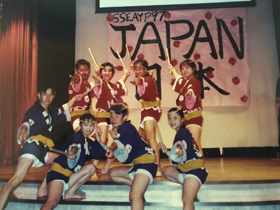 © Namiko Sakai |
|
S: When I was a child, taiko was not as accessible for normal people unlike how it is now. Now, there are schools and more opportunities to start. During my time, the only time we could see taiko was at festivals like bon odori (盆踊り). My classmates would play taiko on a yagura platform (a type of bandstand erected during festivals on top of which taiko players would perform) and it was cool but I didn’t have the chance to play. When I joined SSEAYP in 1997, all of us had to present Japanese cultural performance and there were some choices, of which taiko was one. I decided to join taiko and actually studied under Oedo Sukeroku Taiko, a professional group for a certain period of time and performed taiko during the programme. After the programme, most of the members stopped playing but I wanted to continue. At the time, I was living in Tokyo and I tried looking for a group I could play with. Luckily enough for me, I found a local group with a lot of taiko enthusiasts and I loved it.
When I started taiko, it wasn’t so much a stage performance art but more of a local community activity. When there was a performance or festival, we enjoy drinking beer and talk about taiko after performing. That was my first impression of taiko and I was very happy to continue with the locals. So, when I decided to come to Singapore, I tried to search for a place where I could continue to play, even before I searched for a place to stay and a job! Unfortunately, I couldn’t find a place to continue but I didn’t want to stop as that is where my passion is. I love taiko because it’s not just the music, but it’s good exercise and also, it’s like a form of communication. It’s music but it is also a type of performing art. I enjoy performing with friends and we enjoy seeing the audiences enjoy themselves. Those are happy moments for me, so I wanted to continue even though I was in Singapore. |
|
JCC: You have consistently gone back to Japan to learn and master new performances to bring back to Singapore to teach your students. Why do you do so?
S: Actually, many people ask me this question and I can give many reasons but the simple answer is just because I like it. I really love Japanese culture, especially local cultures. I like very localised things like geinoh (芸能), folk culture. They are not doing it full-time, but they are great masters that you learn from. Usually, these folk cultures are difficult for outsiders to learn but I was very lucky to have very special goen (ご縁, referring to a special connection, or affinity) to be able to meet a lot of special people from Iwate Prefecture somehow. |
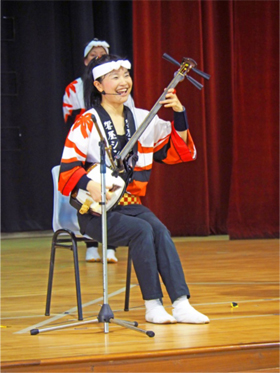 © Namiko Sakai |
|
Even though we (Hibikiya) started as a taiko group, in recent years, we have been doing a lot geinoh, which takes a longer time to master. You need a lot of costumes and props, but it is really interesting. The feel of having the members, known as nakama (仲間) in Japanese, doing things together is something I like – geinoh is something we can’t do alone. Even though you have a dancer, the music is always live so you will need musicians. It is special to me how they connect and how they try to make music for the dancers. When the dancers feel good, they dance well.
With taiko, in a way, it is easy to wow the audience. It’s loud, and it is easy to entertain. I am lucky to be able to learn geinoh and ohayashi. Ohayashi (お囃子) is festival music, usually with less drums. In festivals, there are many audiences, musicians, and dancers. Even though not everyone is under the spotlight, they are all part of the festival. By introducing geinoh, I hope my members feel this nice feeling, kimochi ii (気持ちいい) in Japanese. That’s one of the reasons why I go back to Japan, so that can keep feeling this feeling and share it. JCC: What kind of events and activities have you supported and participated in in Singapore? S: We are lucky to have had various opportunities to perform at big events organised by both the Singapore and Japanese governments, as well as by other organisations. We have even performed outside Singapore too. In Singapore, we have performed at the Chingay Parade 3 or 4 times, and sometimes we even got our masters from Japan to perform together with us as well. We also performed for the F1 two years ago. A festival I like very much is the Summer Festival because there are so many people coming together to enjoy the festival. For JCC, I actually performed for its opening! |
| One of the festivals that we do annually and have fun at is the Sakura Matsuri (Sakura Floral Display) at Gardens by the Bay. I think this is one of the most famous events in Singapore where you can enjoy cherry blossoms. We performed there three times, and each time we tried to introduce something new. Last year, we actually showcased two special geinoh items, oni kenbai (鬼剣舞) and sansa odori (さんさ踊り). Both are from Iwate Prefecture, which I visit every year. People really enjoy these because we as one group can do so many types of performances. I also tell our members that we have to feel happy and to enjoy our performance, so that the audience can feel it! This year, we are quietly, secretly preparing some new items as well so I hope those who came last year will happily come to Sakura Matsuri (Sakura Floral Display) this year again to witness our performance. | 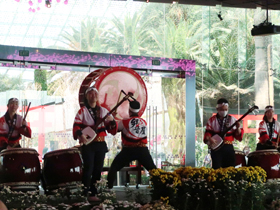 |
|
JCC: Which aspect(s) of Singapore culture do you like or appreciate?
S: I like the feeling of “rojak” because there are many different people from different backgrounds and nationalities. It has given me a lot of chances to meet with various people. Even in Hibikiya itself, we have Singaporeans of course, Malaysians, Chinese, German, French, Russians and more. When I say “Sore! Ha!” (a type of shout used in traditional Japanese music performance), we all play taiko together. Also, I get the chance to perform with a lot of different music groups. Sometimes we perform together with Malay and Chinese music groups. We had an opportunity to perform with many percussionists in Singapore for the Marina Bay Countdown during SG50. There were fireworks set to live percussion instruments. We were the Japanese drummers, and there were Korean, Malay, Indian, Western, Samba drummers too. This kind of opportunity is really interesting and eye-opening for us. JCC: How have you kept Japanese culture alive at home with your family? S: I don’t think I do anything special at home, but my husband and son have been watching how I teach and how I communicate with our masters. I think they naturally experience and see how it’s supposed to be. My son is actually very good at communicating with masters, and the words that he chooses when he communicates with masters are good. It’s not because I taught him anything in particular. I just do what I need to do, what I’m supposed to do, and by doing that, my husband and my son learn. My son was born in Singapore and he went to the Japanese school, so he really understands the Japanese culture. I speak to my son in Japanese, and I’ve been asking my husband to speak to him in Chinese but I think most of the time they speak in English. (laugh) My husband’s Japanese is a little bit feminine, because he learns by listening to what I say. His vocabulary is very good, and sometimes he surprises me by suddenly saying something that I have never taught him. I have to be very careful with the words I use because he copies them. JCC: How did you get your husband and son to appreciate Japanese culture and develop a passion for taiko and geinoh? |
| S: In my husband’s case, he was actually a photographer. He used to take photos of my son and me performing. Somehow, I can’t remember exactly what occasion it was or when it was, but he had to come perform with us. Now, over the years, he has started to really enjoy performing on stage. He’s actually one of the only performers for certain geinoh, like shishi-mai (獅子舞, Japanese lion dance). If you’ve ever seen Japanese lion dance in Singapore in the past 10-11 years, that’s him. I cannot do it, and no Japanese in Singapore can do it, so now he’s trying to teach other members how to do it.
He has also been doing karate, actually, so his body structure is very good for geinoh too. When I brought him to Iwate Prefecture, all the masters said that his body structure is suitable for onikenbai. For Japanese geinoh, we need a lower centre of gravity, and a very stable structure. He was loved by the masters, and his smile somehow attracted them too! (laugh) |
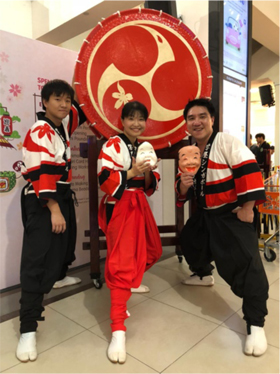 © Namiko Sakai |
|
For my son, it was just natural for him to follow me. Even when he was inside my tummy, I’ve been playing taiko. Actually, taiko sounds resemble a mother’s heartbeat so even when I was playing taiko and there was so much vibration, he could happily sleep on the floor! For him, taiko was just there all the time. He started performing at events with us at a very young age.
My son is a very good performer. He is very good technically, partially because he started young, even before he was born. My son is young, but his ability and depth of experience is a lot. He also has this showmanship, what we call hana (華). My husband has aji (味), flavour, so he looks very good especially for certain geinoh items. I’m really lucky that three of us have different specialties and strengths. It’s not just the skill, but as a performer, we have to have the whole package. Actually, within the three of us, we are teammates but also rivals. We have a healthy competition. JCC: How did you practice taiko before getting your own studio? S: In the very beginning we had to practice at home because we didn’t have a studio. The very first time we started, I only had one drum. Taiko is loud, so I used a cushion to cover it, and we practised hitting it in the living room. At that time, it was only me and my son practising. When we started to have other members, we began renting a small music room on weekends. Every time we practised, we had to bring the drum to the car, then go to the place, clean the instruments in the music room, bring in the drums, practise, keep the drum, put back the instruments, go home, and put the drums back at home. That is how we started. We are so lucky now. We can use our studio any time and we have all the instruments ready. Some of our members have been with us for more than 10 years and these people know how fortunate we are. When we first started, it was not easy. |
|
JCC: Do you have any future plans in mind, or an ultimate goal that you wish to achieve?
S: If you asked me the same question 10 years ago, my answer would’ve been to have a taiko festival in Singapore. I would’ve maybe given the same answer 5 years ago. After that, my direction changed a bit. In Singapore, there are some taiko groups, so I wanted to actually connect with these groups to do something but over the years, I realised that every group has a different direction. We do a lot more than just taiko, because my passion is too strong, in a way. People who understand my passion can follow but I cannot force everybody to follow. Instead of doing big things like festivals or competitions, I thought, what is the best that I can do? What is the thing that only I can do? The things I do may not be big, and may not reach the whole of Singapore but I have a bigger impact on those who come to Hibikiya, whether they come to a performance or if they are a member here. Or, if they watch this video! I feel that’s also a type of goen. |
| I want to reach out and I want to introduce Japanese culture to many people, but many people in Singapore are already enjoying various popular Japanese culture, such as anime, cosplay and food. Therefore, I want to promote traditional and local cultures that are still not commonly known to Singaporeans. I am a Japanese who loves Japanese culture, and I often visit many places in Japan. At the same time, I have been living in Singapore for 20 years, and we have been doing many activities at Hibikiya with our passionate members for more than 12 years. | 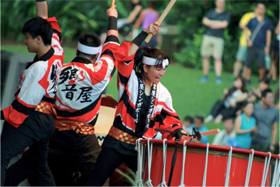 © Namiko Sakai |
|
With all these experience and goen with the local people, I believe I can be a bridge between Singapore and Japan in our unique way. Instead of just a one-time showcase or introduction, we can continue to promote these cultures by keeping close relationship with both the local hozonkai (preservation society) and enthusiasts in Singapore. By doing these, I hope Hibikiya will be a unique and interesting place where passionate people can meet other nakama (members) and enjoy doing what we are doing together – making us the “only one” instead of being the “number one” in Singapore.
JCC: What is a piece of advice you would give to people who are also trying to promote traditional culture? S: Pop culture and traditional culture, both are good and interesting, and attractive in different ways. However, pop culture is more accessible to everyone and you can enjoy it with or without deep understanding or knowledge. In that manner, actually, taiko is similar. You can simply enjoy taiko without understanding the history. But, when we showcase geinoh or ohayashi, we will try to introduce its background or history to the audience, and by doing this, we hope they will be able to feel as if they have travelled to Japan in person to enjoy a festival or scenery with us. Then, how do you appeal to the people in Singapore? That’s what I’ve always been asking myself. Being able to explain or introduce in another language is actually very important. I also have had opportunities to help interpret for some artists. Because I am a performer myself, so when I help the artists or performers from Japan, I can explain not just the word, but the concept. If the translator is perfect but not interested in Japanese culture, the context and meaning that the performer wants to show might not reach the audience. |
|
We are very lucky to have a lot of opportunities to go to different countries. We are representing Japanese culture but we’re actually based in Singapore, so why do people invite us to represent Japan? Perhaps, one reason is because we can communicate in English. Our group can present the performance in Chinese, Malay, English, and Japanese. This is one of our fortes as well. It is very important to be able to introduce, to communicate, and understand the audience.
Last but not least, I believe the most important thing is, if you are introducing something, you have to really love it and you have to show that you love it. Don’t hesitate to show that you love it. I believe that when I talk, you can see that I like it very much. It’s very lucky that we have opportunities to show our love for geinoh at live performances. Watch the interview here. |
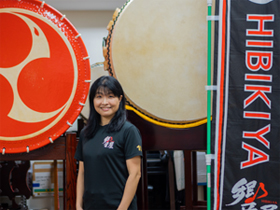 |
* All photos used in this article are taken by JCC / © JCC unless otherwise stated
|
Japan Creative Centre 4 Nassim Road, Singapore 258372 +65 6737 0434 / jcc@sn.mofa.go.jp https://www.sg.emb-japan.go.jp/JCC/ Nearest parking at Orchard Hotel & Delphi Orchard |
 |